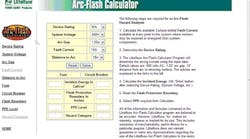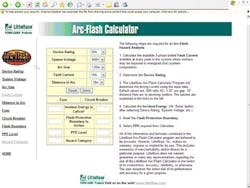Should you outsource electrical hazard assessments?
OSHA regulations and NFPA standards (OSHA 1910 and NFPA 70E) require employers to identify and evaluate electrical hazards in the workplace, and to establish safe work practices and PPE for workers. This includes not only possible shock hazards, but also an assessment of electrical Arc-Flash hazards, as described in the 2004 edition of NFPA 70E. An Arc-Flash assessment is critical, as such events generate intense heat and arc blast pressures that can cause severe burns, concussions, falls, and associated injuries. These events are a leading cause of death among electrical workers.
However, you dont necessarily have to perform this assessment in-house, and there is always the danger of getting it wrong if you do. Electrical hazard assessments are complex, and unless you understand the special expertise required you risk falling short of OSHA requirements. For instance, the sections of 29CFR1910 relating to Personal Protective Equipment (PPE) selection are based on industry standards such as NFPA 70E and the IEEE1584 guideline. These standards and guidelines are used to calculate heat energy associated with an Arc-Flash event based on fault current, fault clearing time, and other factors.
Resources and expertise needed
Beyond technical qualifications, one of the biggest advantages of using an outside hazard assessment firm is readily available personnel and resources. Often, in-house assessments are something that plant managers have precious little time for, and may never be fully completed. By selecting an engineering services firm with adequate personnel and resources, they can handle the entire assessment project. Obviously, they should have enough people and resources for the size of your plant and scope of work needed, including employee training and implementation of corrections. The firm should have both electricians and engineers on staff, and their resources should be in close proximity to your facilities to avoid excessive travel costs.
Because your company is liable when anyone works in your plant (employees or third party personnel) the group doing the assessment must be able to gather data safely. This includes a written protection plan for gathering data while all systems are energized, and documented proof of workers safety training in equipment and tool usage. These plans and work practices must adhere to NFPA 70E guidelines and OSHA rules.
The fact that your plant shares liability in case there is an electrical accident is another reason to use an outside firm. Typically an assessment firm carries general liability insurance and professional liability insurance for errors and omissions. (Dont hire a firm that cant present proof of current liability coverage!)
On the other hand, one reason to use in-house staff to do an assessment is cost savings. Assessments may take months to complete, and the cost can add up. Another reason is that in-house personnel should be thoroughly familiar with your plant and processes.
Hazard labeling is another consideration. This may seem mundane, but the National Electrical Code (NEC) mandates that equipment have warning labels that clearly identify electrical shock and Arc-Flash hazards. These requirements are supported by OSHA. Your company or the outside firm must be able to produce these equipment hazard labels in substantial volume. Furthermore, the labels must be correctly installed to correctly identify hazards and avoid possible liabilities.
The cost of getting it wrong
OSHA publication 29 CFR 1910 clearly spells out employer responsibilities in assessing the workplace to identify potential electrical hazards, and protecting workers from them with appropriate work practices and personal protective equipment (PPE). Hazard assessment and work practice errors are costly. Failure to fully comply with OSHA requirements puts workers at risk and can result in fines and exposure to multi-million dollar lawsuits. In 2005, OSHA assessed employers over $34 million in fines, 44% of which were due to electrical hazards.
With the stakes so high, it is imperative that companies accurately assess their electrical infrastructure and configuration, including the equipment and work practices for all actual and potential electrical hazards, especially shock and Arc-Flash hazards. Because of such complexities, most companies seek an engineering services firm to perform a comprehensive electrical hazard assessment of their facilities. In any event, before attempting an in-house assessment, or selecting a third party for the job, consider the requirements described below.
Technical qualifications
Arc-Flash calculations can be performed by an engineer or a plant electrician free software is available from many companies for this purpose. However, as with most free software, many assumptions are made in the calculations, which may not result in an accurate determination of incident energy levels or boundaries. The information that is required for the calculations includes knowledge of cable length, diameter, metal type, overcurrent protection, and utility service into the plant.
Fig. 1. Basic Arc-Flash calculation software is freely available at http://www.littelfuse.com/arccalc and other websites, but it less sophisticated than the software used by professional engineering firms.
Employee training
Few plants are staffed with training personnel for comprehensive electrical hazard education programs.
Therefore, its best to use an engineering services firm that can follow up an electrical hazard assessment with employee safety training and continuing audits, using their dedicated, experienced trainers on staff. Topics covered during training should include:
- Standards that govern electrical work and their requirements, including NFPA 70E and others
- Electrical safety work practices, including lockout/tagout procedures per 29 CFR 1910
- Applicability of other OSHA or state rules and penalties for noncompliance
- The difference between qualified and unqualified workers, and work limitations for unqualified workers
- Comprehensive examples of acceptable and unacceptable work practices, including those in wet or damp locations
- Use of key interlocking systems
- Identification of type and level of hazards, including electrical shock and Arc-Flash
- Identifying energized components and conductors
- Determining nominal circuit and equipment voltages
- The use of voltage sensors and meters
- Interpreting hazard warning labels
- Safe approach distances to exposed electrical conductors
- Rules for authorized "Hot Work" and use of Live Work Permits and Job Briefings
- The consequences of poor electrical safety practices to people and equipment
- Personal Protective Equipment (PPE) requirements, including selection, proper use, and maintenance
- Required and recommended maintenance and safety inspections
- Grounds and Grounding
All of this training should include appropriate job aides. Furthermore, it should be integrated with the employers standard operating procedures and policies of enforcement.
Larry Altmayer has been teaching and training electrical maintenance supervisors, safety managers, electricians, safety engineers and consultants for more than 10 years. He has co-written or contributed to the Littelfuse Electrical Safety Handbook and has published articles on electrical safety, protection, and controls. Larry Altmayer has given hundreds of presentations to engineers, managers, and electrical workers on electrical safety, NFPA and OSHA regulations. He has worked closely with the OSHA National Training Institute.

